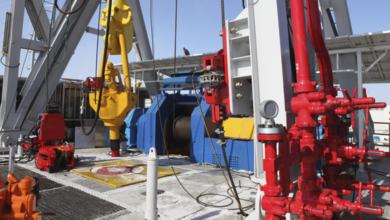Drilling Ahead: ‘Brick wall’ looms for offshore jobs
By Mike Killalea, editor & publisher
As the moratorium on deepwater drilling creeps toward its purported 30 Nov end date, efforts to jump start drilling in shallow water remain bottle-necked by a parching trickle of approved permits.
Since April, the government has signed off on just four permits for new-well drilling in the Gulf of Mexico since the Macondo blowout – four. (as of 31 Aug.)
Despite this dreary statistic, a sentiment has been propagated in certain media that predicted job losses have not played out. This notion springs, it seems, from the misconception that offshore jobs are like a light switch – turned off or on all at once.
The reality, like most realities, is more complex. Jobs will be imperiled as rigs are laid down following completion of projects. Without permits forthcoming in any reasonable time frame, employers will ultimately have no choice but to cut workers loose. A very unfortunate – and eminently avoidable – result.
IDLE RIG FLEET GROWS
By the end of August, 26 of the 46 available jackups in the Gulf of Mexico will be awaiting government permits, according to the Shallow Water Energy Security Coalition, which comprises IADC-member GOM jackup owners. By the end of September and October, absent new permits, the idle-rig number swells to 28 and 37, respectively. Workovers and sidetracks, which can continue, may mitigate this, but the rigs need to drill.
The major hurdle is approval of permits under the Bureau of Ocean Energy Management, Regulation & Enforcement’s Notice to Lessees 2010-N06. N06, issued on 18 June, instructs operators what information they must submit for worst-case discharge scenarios in case of a blowout. It is the second of two NTLs issued in the wake of the Macondo blowout.
The first, NTL 2010-N05, deals with BOP certification and other equipment issues. The industry responded robustly to N05. By late August, 107 permits were approved under N05 for water depths of 500 ft or less, and 36 for deeper water, according to the BOEM website.
“We got that done post haste,” remarked John Rynd, CEO of Hercules Offshore Inc. Mr Rynd is a leader of the shallow-water coalition and a member of the IADC Executive Committee.
REGULATORY IMPASSE
The second NTL is more problematic, however. “N06 is the one that has everything grinding to a halt,” Mr Rynd said.
N06 sets forth no new requirements, but details what information must be supplied. And therein lies the rub. Explained Jim Noe, Senior Vice President for Hercules, BOEM first insisted operators use the absolute open-flow rate as the worst-case discharge figure in plans and applications. Operators, though, point out that geologic conditions must be considered, including known reservoir characteristics, analog reservoir information, offset production and other factors.
“It’s an impasse,” Mr Noe said.
Further, BOEM personnel are strained to the breaking point. Mr Noe was told by senior agency officials that processing each submission under N06 requires 150 manhours. The Shallow Water Energy Security Coalition and the Gulf Economic Survival Team collected data from BOEM records and polled more than 20 operators. The findings revealed that BOEM has 44 plans under review, and another 14 requiring submission of N06 data. Further, the operator poll revealed that an additional 69 plans will be submitted in the next 60 days.
Do the math: “It will require 19,050 manhours for BOEM just to process the new data,” Mr Noe said.
BRICK WALL
Meanwhile, the clock ticks on offshore employment. Absent new permits, and despite oblivious press reports, the day of reckoning awaits the GOM.
“The brick wall is coming,” warned Mr Rynd.
Mike Killalea can be reached at mike.killalea@iadc.org.




I wana get knoledge about drilling new tecnology